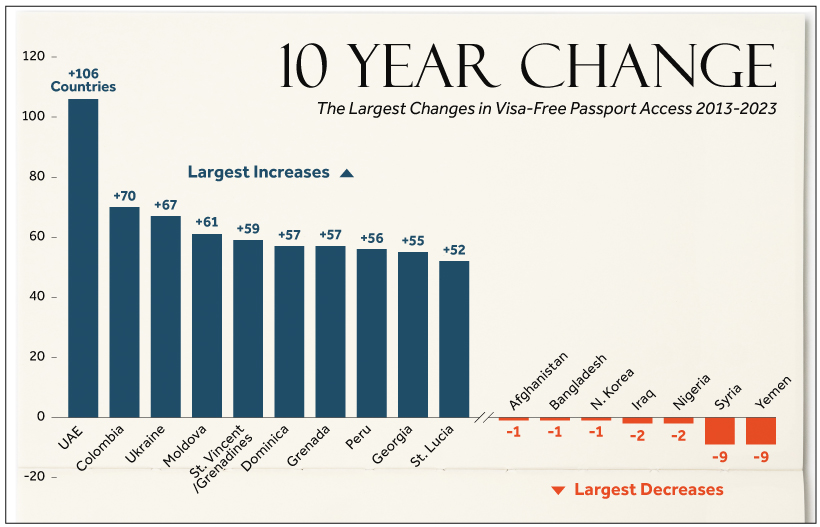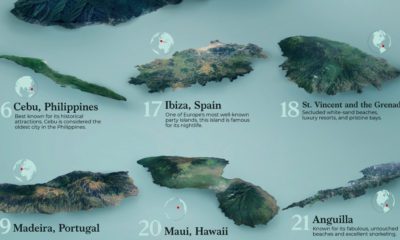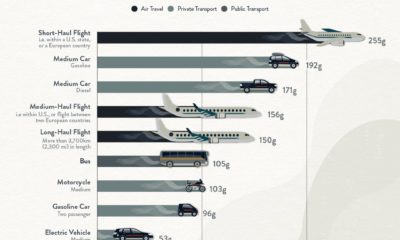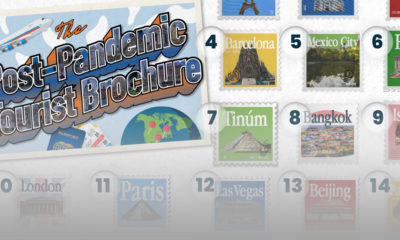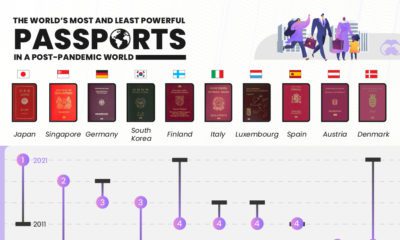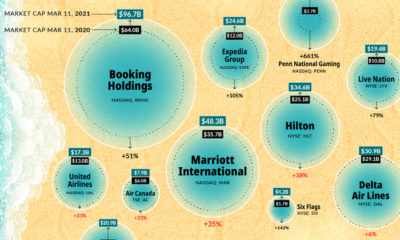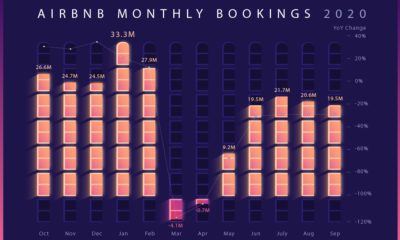But for many across the world, it’s not that easy—a number of passport holders need to obtain a travel/tourist visa prior to arrival. These visas typically require approval from the destination country’s government that can take weeks or months. Japanese passport holders, for example, are able to visit 193 countries without pre-approval (nearly every country on Earth). Afghans, on the other hand, can only visit 27 countries with the same level of ease. This ranking uses data from Henley & Partners, which determines the number of countries to which a passport holder has visa-free access.
The World’s Passports
First let’s look at every country’s position in the ranking in the table below: Visas are imposed by some countries to make it easier to track visitors, allowing a country to assess whether said passport-holder may be a risk for illegal immigration, crime, acts of terror, or covert surveillance. For example, both Russia and China require American passport holders to obtain visas prior to travel, and vice versa.
The Most Powerful Passports
When it comes to the most powerful passports, most of the top 20 are issued by countries in Asia or Europe, with the exception of New Zealand and the United States. Due to multiple ties in the rankings the U.S. technically ranks 17th, having visa-free access to 187 countries, on par with Norway, New Zealand, and Switzerland. Ranking 66th, Ukraine’s passport has actually seen drastic improvement over the last decade, currently getting visa-free access to 144 countries. It has yet to be seen how this will change in the wake of the Russia/Ukraine conflict.
The Least Powerful Passports
Many of least powerful passports come out of war-torn and politically unstable nations. As visas for travel are typically required to counter illicit activity, these nations are often flagged whether justly or not. One immediate standout among the least powerful passports is North Korea. The insular nation has visa-free access to 40 countries, ranking it above eight other passports on the list. Most North Koreans who travel abroad do so only in extremely special circumstances for work, study, or athletic competitions. Leisure travel out of North Korea does not happen, but technically, North Koreans can visit countries like Haiti, St. Vincent & the Grenadines, Palestine, and Kyrgyzstan, among others without a visa.
The Biggest Gainers & Losers Over Time
From a big picture standpoint, the world’s travelers have seen their access improve significantly over the last 10 years. If you’re a citizen of the UAE, for example, your prospects for visa-free travel have improved by 100+ countries over the last decade.
Here’s a closer look at 15 countries with the greatest change in visa-free access: On the other hand, other countries have fared poorly, with some actually losing access to destinations since 2013. Yemen and Syria are tied for first place, having lost visa-free access to nine countries over the last 10 years. Here’s a look at 15 countries who experienced the biggest negative change: Looking at the tables above, it’s apparent that the world has generally become more open in recent years. Overall, the power of a passport is almost directly reflective of the political state of the world. World powers and rich nations typically have free flow of travel, but those facing instability or war are often also face barriers when wanting to go abroad. on Even while political regimes across these countries have changed over time, they’ve largely followed a few different types of governance. Today, every country can ultimately be classified into just nine broad forms of government systems. This map by Truman Du uses information from Wikipedia to map the government systems that rule the world today.
Countries By Type of Government
It’s important to note that this map charts government systems according to each country’s legal framework. Many countries have constitutions stating their de jure or legally recognized system of government, but their de facto or realized form of governance may be quite different. Here is a list of the stated government system of UN member states and observers as of January 2023: Let’s take a closer look at some of these systems.
Monarchies
Brought back into the spotlight after the death of Queen Elizabeth II of England in September 2022, this form of government has a single ruler. They carry titles from king and queen to sultan or emperor, and their government systems can be further divided into three modern types: constitutional, semi-constitutional, and absolute. A constitutional monarchy sees the monarch act as head of state within the parameters of a constitution, giving them little to no real power. For example, King Charles III is the head of 15 Commonwealth nations including Canada and Australia. However, each has their own head of government. On the other hand, a semi-constitutional monarchy lets the monarch or ruling royal family retain substantial political powers, as is the case in Jordan and Morocco. However, their monarchs still rule the country according to a democratic constitution and in concert with other institutions. Finally, an absolute monarchy is most like the monarchies of old, where the ruler has full power over governance, with modern examples including Saudi Arabia and Vatican City.
Republics
Unlike monarchies, the people hold the power in a republic government system, directly electing representatives to form government. Again, there are multiple types of modern republic governments: presidential, semi-presidential, and parliamentary. The presidential republic could be considered a direct progression from monarchies. This system has a strong and independent chief executive with extensive powers when it comes to domestic affairs and foreign policy. An example of this is the United States, where the President is both the head of state and the head of government. In a semi-presidential republic, the president is the head of state and has some executive powers that are independent of the legislature. However, the prime minister (or chancellor or equivalent title) is the head of government, responsible to the legislature along with the cabinet. Russia is a classic example of this type of government. The last type of republic system is parliamentary. In this system, the president is a figurehead, while the head of government holds real power and is validated by and accountable to the parliament. This type of system can be seen in Germany, Italy, and India and is akin to constitutional monarchies. It’s also important to point out that some parliamentary republic systems operate slightly differently. For example in South Africa, the president is both the head of state and government, but is elected directly by the legislature. This leaves them (and their ministries) potentially subject to parliamentary confidence.
One-Party State
Many of the systems above involve multiple political parties vying to rule and govern their respective countries. In a one-party state, also called a single-party state or single-party system, only one political party has the right to form government. All other political parties are either outlawed or only allowed limited participation in elections. In this system, a country’s head of state and head of government can be executive or ceremonial but political power is constitutionally linked to a single political movement. China is the most well-known example of this government system, with the General Secretary of the Communist Party of China ruling as the de facto leader since 1989.
Provisional
The final form of government is a provisional government formed as an interim or transitional government. In this system, an emergency governmental body is created to manage political transitions after the collapse of a government, or when a new state is formed. Often these evolve into fully constitutionalized systems, but sometimes they hold power for longer than expected. Some examples of countries that are considered provisional include Libya, Burkina Faso, and Chad.
